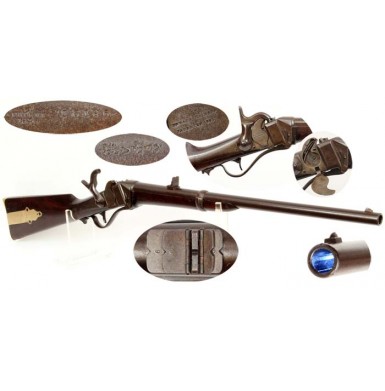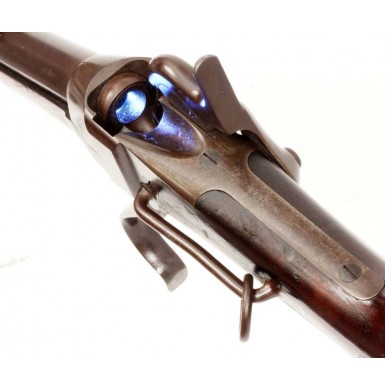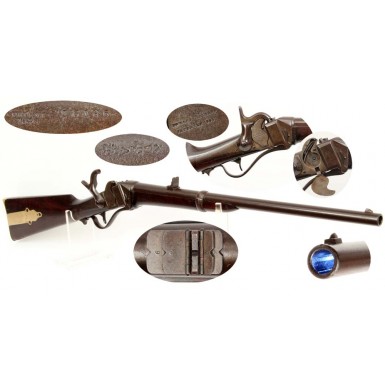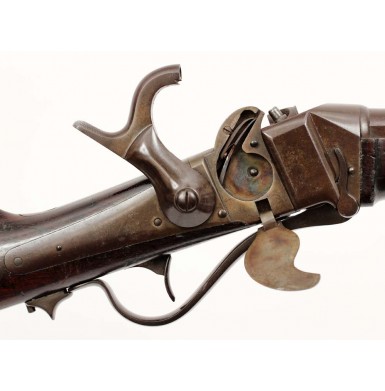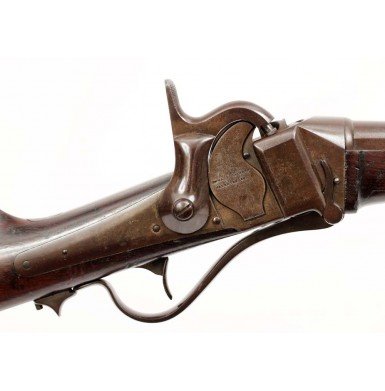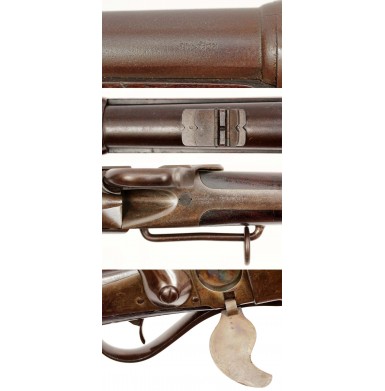British Military Sharps M-1855 Carbine - Very Scarce
- Product Code: FLA-2151-SOLD
- Availability: Out Of Stock
-
$1.00
The Sharps M-1855 Carbine is one of the real rarities of Sharps long arms collecting. Only 6,796 of the M-1855 pattern carbines were produced between May of 1856 and July of 1857. Of those guns, 6,000 were sold to the British on a military contract, 600 were sold to the US Army, 101 were sold to the US Navy and 95 were sold commercially. While 6,000 British contract carbines may seem like a fairly substantial number, these guns are extremely scarce on the American collector market today. The reasons are multi-fold, but essentially revolve around the fact that the arms were part of a foreign contract and were sold to Great Britain, and the British issued the Sharps carbines to five troops of Cavalry stationed in India. The order for the 6,000 carbines came about due to a combination of indecision, a lack of options, and the poor performance of the Victoria carbine. As the British went to war in the Crimea, they found their infantry well armed with the P-1851 Mini” Rifle and the newly adopted and very modern P-1853 Enfield Rifle Musket. However, the cavalry went into battle with the 2nd Pattern Victoria Carbine of 1843. This was a percussion, smoothbore, muzzle loading carbine with a 26” barrel, in .73 caliber. The appearance of the carbine was reminiscent of earlier English flintlock carbines, as the barrel was pinned to the stock, instead of being secured by barrel bands. The carbine had a captive swivel ramrod, and when this feature was combined with the rather long barrel length for a carbine, the end result was an arm that difficult to handle and reload while on horseback. Due to the woeful inadequacies of this carbine on the battlefields of the Crimea, the Board of Ordnance began to seriously look at options for adopting a breechloading rifled carbine that would be easier to handle while mounted, and be more effective on the battlefield. The first serious contender for selection was a patent capping breechloader designed by James Leetch. Leetch’s design had been submitted to the Ordnance Department for review in November of 1853, one month after the beginning of the war in the Crimea. However, Leetch’s design did not undergo serious trials until June of the following year, and was not endorsed for adoption by the Board of Ordnance until July of 1855. Initially some 15,000 of Leetch’s carbine were ordered, but the order was quickly reduced to 2,000 as it was considered prudent to try a number of designs in the field prior to making a final selection regarding a breechloading carbine. In April of 1854, the Sharps carbine design was first examined by the British Board of Ordnance for consideration as a potential breechloading carbine. Testing was conducted in February of the following year, and the results were mostly positive. The Sharps carbine variant tested was equipped with the Maynard patent automated tape priming system, rather than the Sharps pellet primer system. The initial testing went well enough that a month later, in March of 1855, the Board of Ordnance requested that the Royal Small Arms Factory at Enfield Lock produce twelve of the Sharps pattern arms in .577 caliber for additional testing. This testing took place in July of 1855 and resulted in the ordering of 6,000 Sharps M-1855 carbines in .577 caliber. The order was placed on March 26, 1856 and the British deliveries commenced on May 31 of 1856, continuing through March 31, 1858. The guns were produced in two variations, with difference being only the barrel length. According to most references, the first 3,000 carbine were delivered with a 21” barrel, while the next 3,000 were delivered with 19” barrels. This may not be completely true, and the guns may have been delivered with the current available barrel length installed. The guns were blued with case hardened receivers and were mounted with brass furniture, including a brass patchbox in the obverse butt. As previously noted, they incorporated the Maynard automatic tape priming system. The carbines had a fixed block sight graduated for 100 yards, with four additional folding leaves for other distances. The two rear most leaves were graduated to 200 and 300 yards, and the two forward of the fixed sight were graduated to 300 and 400 yards. This system was found to be less than effective, and during the service of the arms a newer version of the sight was adopted with the forward leaves graduated to 400 and 600 yards, respectively. As originally ordered, the carbines had .577 caliber bores, rifled with three grooves and a 1:78” rate of twist. This was found to be inadequate, and sometime in 1857 new specifications were issued, changing the rate of twist to 1:48” and between 1857 and 1859 a number of carbines were re-barreled with 18” barrels with the faster rate of twist and .551 caliber bores. It appears that this was the same time frame that the rear sights were improved as well. The search for the most perfect carbine for cavalry use did not end with the order for Sharps carbines, and in 1858 another competing American design, the Greene carbine was ordered from the Massachusetts Arms Company for field trials. In addition, British designs by Burton, Restell, Terry, and Westley Richards were all considered. In the end, the Westley Richards design was the winner, but it was not universally adopted until 1866! By February of 1864 only 2,877 of the Sharps carbines were still in British service, with the other 3,123 having been removed from service in one form or another. It appears that all of the carbines still in inventory at that time had been modified with the new, shorter, smaller caliber barrels with the faster rate of twist.
Offered here is a FINE condition example of a rare British Contract Sharps M-1855 Military Carbine. The gun bears the matching serial number 26185 on both the receiver tang and on the bottom of the barrel, underneath the forend. This places the carbine in the second half of the serial number production range that these carbines are found in, which is between 19,000 and 29,000. The receiver tang is marked in two lines: PATENT / 1848. The exterior of the door of the Maynard tape priming mechanism is marked in two lines: EDWARD MAYNARD / PATENTEE 1845 and the inside of the door is marked with the sub-assembly number 164. As is typical of the early Sharps carbines, the breechblock is unmarked and unnumbered. The left side of the barrel, ahead of the receiver is marked with a (CROWN) / A / 2 British military inspection mark, with the “A” indicating inspection in America. This is the same inspection mark found on many of the “Windsor” P-1853 American contract Enfield rifle muskets produced at the Robbins & Lawrence Factory. The barrel also bears a British military acceptance mark of a (CROWN) / “P / V, with the first letter before the “P” not being legible. The only other marks visible without disassembly are an illegible pencil mark in the patch box, as well as a + mark. I believe that this “+” indicates better than normal grade wood, as the stock is particularly nice and well figured. The carbine has a lovely, thick chocolate brown patina that is untouched and uncleaned. The barrel retains traces of its original blued finish, mixed with the dark patina. The exposed portion of the barrel shows light to moderate pinpricking over its entire surface, with some light pitting in the breech area, and patches of lightly oxidized surface scale. The underside of the barrel, protected by the forend, is completely smooth and retains about 90%+ of its original plum brownish colored blue finish. The bore of the carbine is in about FINE condition. It is mostly bright and retains crisp three-groove rifling. The bore shows light to moderate oxidation and roughness in the chamber area, and the first few inches forward of there. The balance of the bore shows only scattered pinpricking and light pitting along its length. The breechblock retains about 10% of its original vivid case colors on the exterior, mixed with a smooth, and slightly mottled plum brown patina. The interior of the block retains about 40%+ of the original case coloring, with vivid coloring inside the Maynard tape primer recess, muted colors on the block. Both the breechblock and the interior of the tape primer door have a smooth plum patina with traces of case coloring. The action of the carbine is very crisp and remains mechanically excellent. The breechblock opens smoothly and locks tightly into place. The Maynard tape priming system is complete and fully functional. The hammer operates crisply on all positions and responds to the trigger, as it should. The tape primer door opens smoothly, but remains closed as it should and even the breech lever locking latch functions as well as the day the carbine was manufactured. The carbine retains its original sling bare and ring on the left side of the receiver. The correct, post-1857 British modified block & 4 leaf sight is in place on the barrel, forward of the receiver, with the original 200, 300, 400 and 600 yard leaves all in place. The original front sight is in place near the muzzle as well. The original cone (nipple) is in place in the breechblock and it remains very crisp. All of the screws remain crisp as well, with only the most minor slot wear noted. The wood to metal fit is outstanding and all of the brass hardware has an attractive, lightly cleaned, golden color. The stock and the forend of the carbine are in about EXCELLENT condition. They are made from a superior quality piece of highly figured walnut, which is of a much better grade than military service carbines are usually made from. The stock is solid and complete and free of any breaks, cracks or repairs. The stock retains very fine and crisp edges and has never been sanded. The stock shows only a handful of minor bumps and dings from handling, use and storage, but absolutely no abuse. The stock is really outstanding and must be seen in person to be appreciated.
Overall this is a really great example of a very scarce Sharps military carbine. British M-1855 Sharps Carbines are rarely found for sale in the United States, and are missing from many of even the most advanced collections of Sharps carbines and rifles. When the guns are found, they typically show serious wear from their hard use by the British cavalry in India, and they are rarely as wonderfully crisp and complete as this one. This one is 100% compete and correct in every way. This carbine is a must have for any serious Sharps collector or any advanced British military carbine collector. The gun is simply wonderful, has tons of eye appeal, and is very difficult to find for sale. You will have to wait a long time, and pay a lot more money to find a better example of this rare and desirable Sharps carbine.
SOLDTags: British, Military, Sharps, M, 1855, Carbine, Very, Scarce

